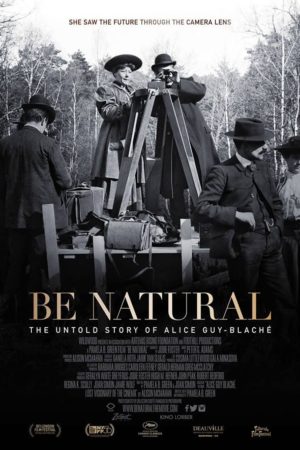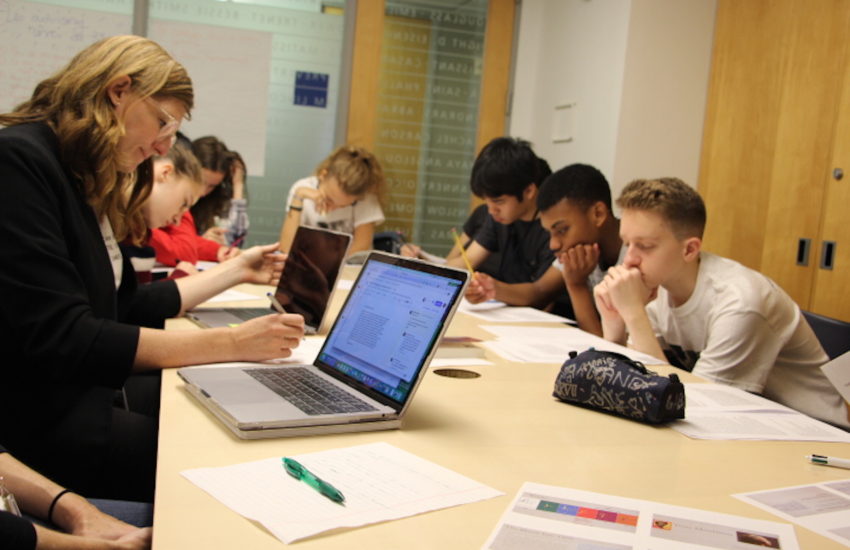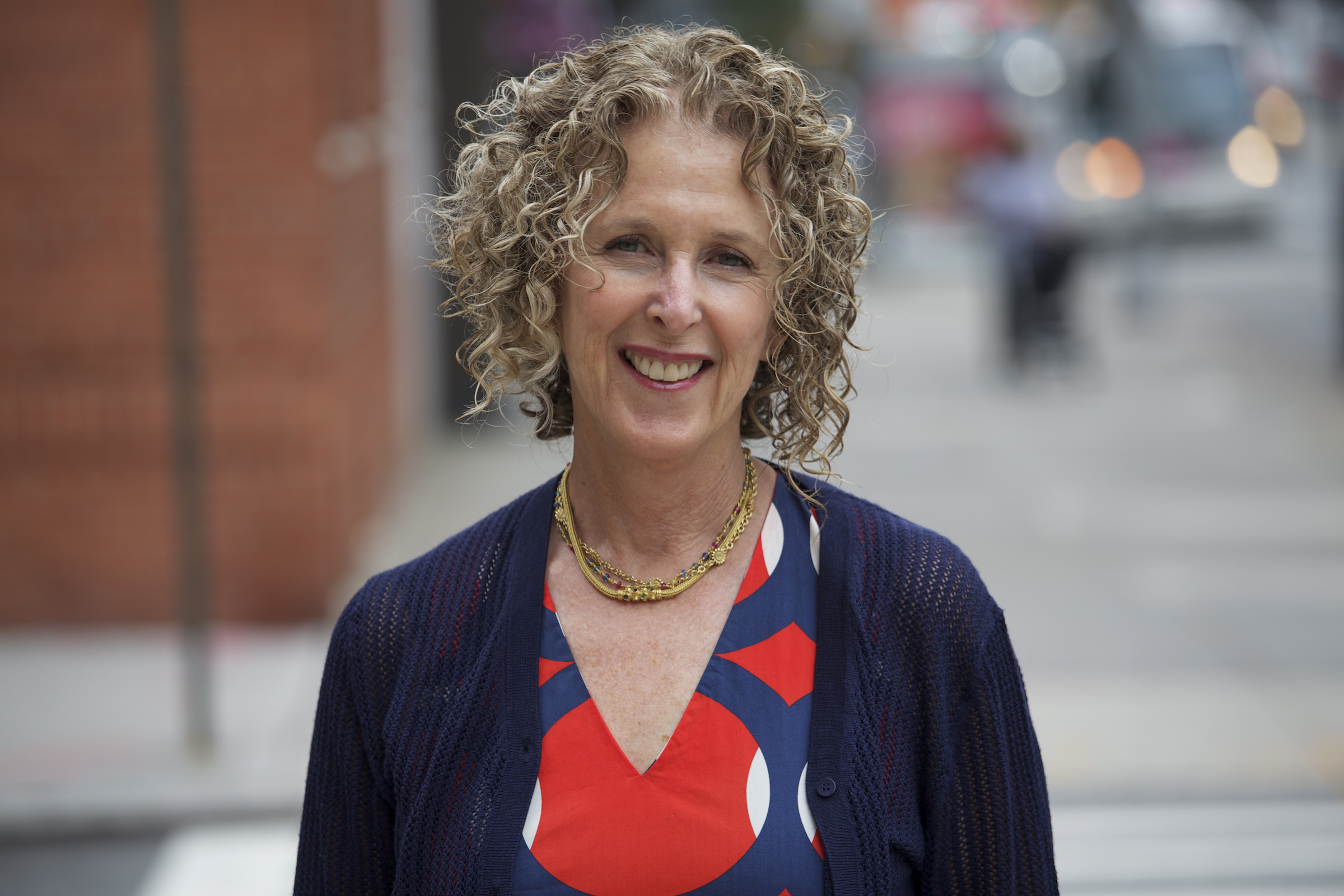“Blues music is elegance in the face of adversity,” jazz bandleader of Sammy Miller and the Congregation told students at the beginning of the Lycée Français de New York’s third annual James Baldwin Day—curated by the Secondary English Department. The beauty of this sentiment barely had enough time to settle over the eager body of students before the snare drum kicked, and the hi-hat jumped, and the band shot into a truly mellifluous rendition of Count Basie’s “Rusty Dusty Blues.”
The day began with the performance of a prose poem created by Mme George and the students of 1ere OIB. It was composed of fragments from four different texts that circled around James Baldwin: His own famous “Letter to my Nephew” of 1961, Alain Mabanckou’s lyrically eulogistic “Lettre à Jimmy,” written in 2007 on the 20th anniversary of Baldwin’s death, Ta-Nehisi Coates’ masterful epistle to his son, “Between the World and Me” (2015), and the searing Richard Wright poem (1935) that Coates evokes in his title. The performance was a choral exchange of voices all centered on questions of identity, love, and the traumatic history of race in the U.S. The students chose passages to read aloud, to one another, and to all of us, so we could step into the epistolary exchange, if only briefly, and honor these writers. They did an outstanding job.
 The day continued with breakout sessions into workshops. English teachers Ms. Laurens and Ms. George carried the blues music theme into a deep reading of the first page of Toni Morrison’s novel, Jazz. Under the guidance of Ms. Lauren’s soothing voice, students did a creative writing exercise, trying to unlock the text’s sensory rendering of Harlem in the 1920s by describing their own experiences of walking around New York City.
The day continued with breakout sessions into workshops. English teachers Ms. Laurens and Ms. George carried the blues music theme into a deep reading of the first page of Toni Morrison’s novel, Jazz. Under the guidance of Ms. Lauren’s soothing voice, students did a creative writing exercise, trying to unlock the text’s sensory rendering of Harlem in the 1920s by describing their own experiences of walking around New York City.
“Her optimism is a self-deception, but I think her strength is real,” said one student about Jazz’s heroine, Violet.
In Ms. Hollow and Ms. Leger’s children’s literature workshop, students delved deep in their own memories to rediscover the sights, sounds, textures and dialects of their own not-so-distant childhoods. Ms. Reilly and Ms. Neall led a foray into the “personal letter” genre by reading some of James Baldwin’s own personal correspondences, along with letters by Nikki Palumbo and Caitlin Moran, as a guide.
In another room, guest lecturer Dr. Dohra Ahmad of St. John’s University gave students a deep-dive into the theme of exile in poetry—from Claude McKay, a Jamaican expatriate poet of the Harlem Renaissance, to contemporary British-Somali poet Warsan Shire. Students were then asked to write about what home means to them.
“What is home, and how does the meaning of home change if you have to leave it?” Dr. Ahmad asked.
Further down the corridor, math teacher Mr. Soquet along with senior Henry ‘20 led a lively dialogue about the music of Marvin Gaye and Stevie Wonder. Students talked about storytelling, voice, and the power of music to lift up activist movements. Mr. Samulski and Mr. Tasevoli taught a workshop about boundary-pushing in cinema, Ms. Patouillard hosted a Wikipedia edit-a-thon, Mr. Plaza walked students through a few historic Supreme Court cases that define race and citizenship in our country today, and Ms. Garcia hosted a rousing debate.
 All of this was to honor the legacy of James Baldwin, American writer, citizen of France, and citizen of the world, whose words resonate so much. James Baldwin was a man who sought to understand and celebrate his racial heritage as it was expressed throughout Europe, Africa, the Caribbean as well as in the US and it was because of his deep understanding of this heritage that he returned to the US from France in order to take his native country to task for its failure to recognize and fight against injustice and discrimination.
All of this was to honor the legacy of James Baldwin, American writer, citizen of France, and citizen of the world, whose words resonate so much. James Baldwin was a man who sought to understand and celebrate his racial heritage as it was expressed throughout Europe, Africa, the Caribbean as well as in the US and it was because of his deep understanding of this heritage that he returned to the US from France in order to take his native country to task for its failure to recognize and fight against injustice and discrimination.
Many thanks to the English department for their creativity and generosity. Thanks to Pascale Richard and Annie Paillard for helping with the many details that go into planning a day like today. Thanks so much to our workshop leaders, faculty members and friends of the house who volunteered and worked hard to plan interesting and provocative sessions for the day. Thanks to our T-shirt team. And, finally, thanks to M. L’Hotellier who continues to be a great problem solver and general say-yes guy.
The day concluded with a screening of Be Natural: The Untold Story of Alice Guy-Blaché, followed by a Q & A with director Pamela Green.
About the Author :
Before coming to the Lycée, Robin Aufses was the English department chair at J.F. Kennedy High School in Bellmore, New York, and an English teacher at Schreiber High School in Port Washington, New York. Robin is the author of College-board published articles about literature and co-author of The Language of Composition, Literature and Composition and Conversations in American Literature. She lives in Manhattan with her husband Arthur, a lawyer. They have two children, Kate and Michael.


